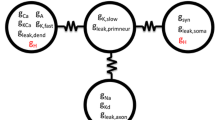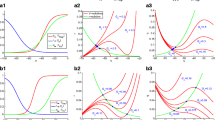Abstract.
Chaotic bursting has been recorded in synaptically isolated neurons of the pyloric central pattern generating (CPG) circuit in the lobster stomatogastric ganglion. Conductance-based models of pyloric neurons typically fail to reproduce the observed irregular behavior in either voltage time series or state-space trajectories. Recent suggestions of Chay [Biol Cybern 75: 419–431] indicate that chaotic bursting patterns can be generated by model neurons that couple membrane currents to the nonlinear dynamics of intracellular calcium storage and release. Accordingly, we have built a two-compartment model of a pyloric CPG neuron incorporating previously described membrane conductances together with intracellular Ca2+ dynamics involving the endoplasmic reticulum and the inositol 1,4,5-trisphosphate receptor IP3R. As judged by qualitative inspection and quantitative, nonlinear analysis, the irregular voltage oscillations of the model neuron resemble those seen in the biological neurons. Chaotic bursting arises from the interaction of fast membrane voltage dynamics with slower intracellular Ca2+ dynamics and, hence, depends on the concentration of IP3. Despite the presence of 12 independent dynamical variables, the model neuron bursts chaotically in a subspace characterized by 3–4 active degrees of freedom. The critical aspect of this model is that chaotic oscillations arise when membrane voltage processes are coupled to another slow dynamic. Here we suggest this slow dynamic to be intracellular Ca2+ handling.
Similar content being viewed by others
Author information
Authors and Affiliations
Additional information
Received: 24 February 1999 / Accepted in revised form: 17 December 1999
Rights and permissions
About this article
Cite this article
Falcke, M., Huerta, R., Rabinovich, M. et al. Modeling observed chaotic oscillations in bursting neurons: the role of calcium dynamics and IP3 . Biol Cybern 82, 517–527 (2000). https://doi.org/10.1007/s004220050604
Issue Date:
DOI: https://doi.org/10.1007/s004220050604




